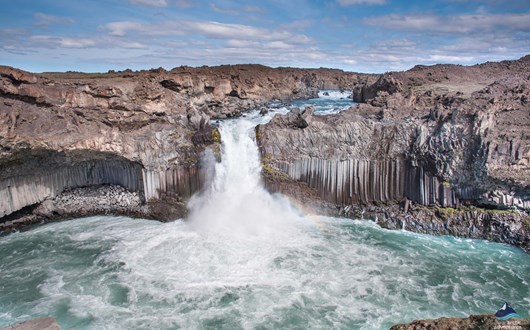
10 Lesser Known (But Equally as Beautiful) Waterfalls in Iceland
Iceland is a true waterfall paradise, everywhere you look, it seems, water is drizzling down in the most gorgeous streams you will want to stop and admire them for hours.
Iceland is not only the land of fire and ice but also home to countless waterfalls. There are so many that some smaller ones don’t even have official names. We picked the best (and most accessible) ones you can include on your itinerary. Here is our top 20 waterfalls list!
Nestled within high mountains, expansive mountain glaciers, and a North Atlantic climate, Iceland boasts a staggering abundance of over 10,000 waterfalls. There are towns and villages where the sound of water tumbling down the mountains is an ever-present signature tune. The people of Iceland fall asleep and awaken to the symphony of multiple cascades, some gently falling, others tumbling and babbling energetically down from the high mountains surrounding the towns.
Get ready to be enchanted by the symphony of the best waterfalls in Iceland that will leave you in awe of nature's grandeur. Many of these are featured on our jam-packed day tours of Iceland!
Let's start with the king of waterfalls in Europe, Dettifoss! Located in Vatnajökull National Park in North East Iceland, this mighty cascade is one of the world-famous waterfalls. Its thundering roar can be heard from miles away, and its colossal size of 45 meters in height and 100 meters in width is genuinely awe-inspiring.
You can approach Dettifoss from both the east and west banks, giving you double the chance to witness its magnificence. As a bonus, just a short 1 km walk upstream, you'll find the charming Selfoss waterfall, standing at 10 meters high. And if that's not enough, below Dettifoss awaits the majestic Hafragilsfoss, cascading down from a height of 27 meters. It's like getting a 3-in-1 deal!
Oh, and did you know that Dettifoss has had its fair share of fame? It made an appearance in Sir Ridley Scott's film Prometheus and even inspired a musical composition by Jón Leifs. Talk about being a celebrity among waterfalls!
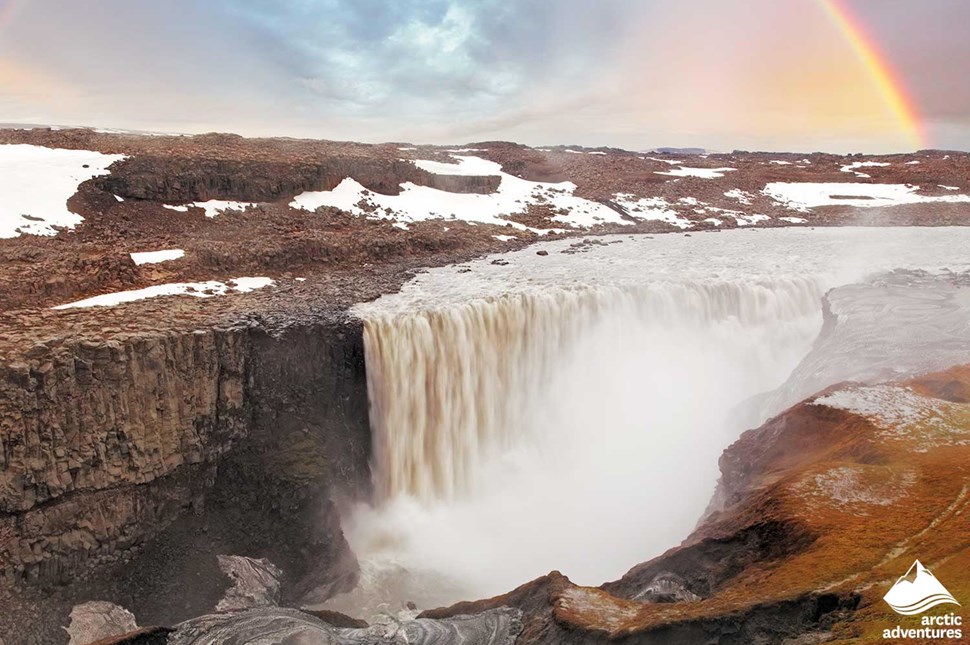
The most powerful waterfall in North Iceland called Dettifoss
In the Westfjords, we have Dynjandi, the “Pearl of the Westfjords,” and the largest waterfall in the region. Picture a bride's veil, narrow at the top and broad at the bottom, gracefully cascading down.
But here's the best part: as you go to the main event, you'll pass by six other charming waterfalls, like a scenic appetizer before the grand feast. It's about a 15-minute uphill stroll, and along the way, you'll find beautiful rest stops by the more minor falls, inviting you to take a moment and soak in the beauty.
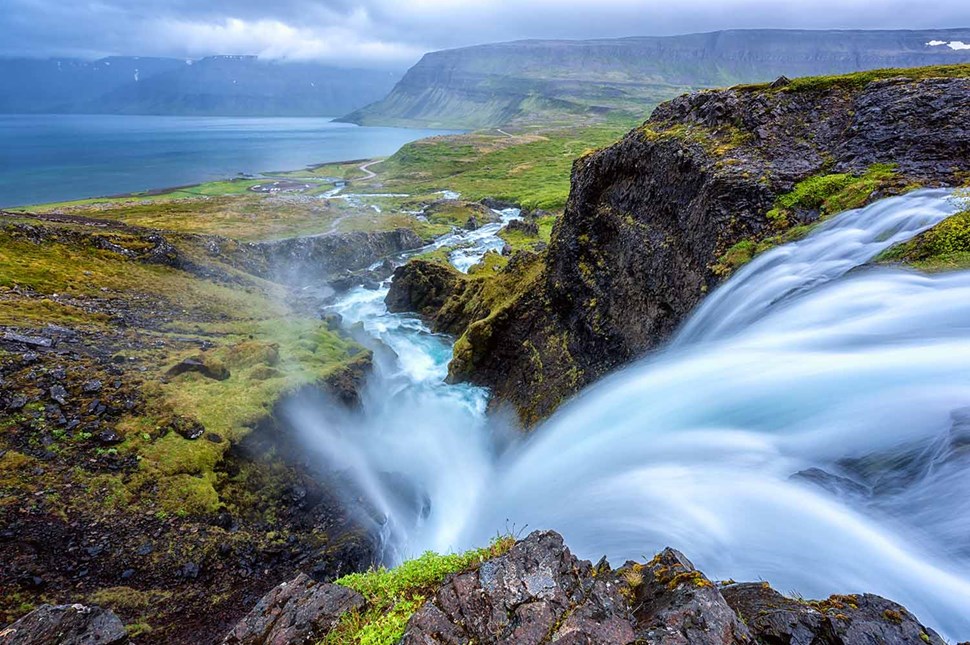
Dynjandi Waterfall
Now, let's uncover a secret hidden behind rocks. Gljúfrabúi, also known as "the secret waterfall," tends to go unnoticed next to its famous sibling, Seljalandsfoss. But trust us, it's worth seeking out. This hidden gem is tucked away behind a wall of rocks, waiting for the adventurous souls willing to get their feet wet.
Its name, "Dweller of the Gorge," suits it perfectly, as it feels like a hidden home for elves or trolls. Remember to bring a raincoat, waterproof boots, or spare socks because you might get a little soaked!
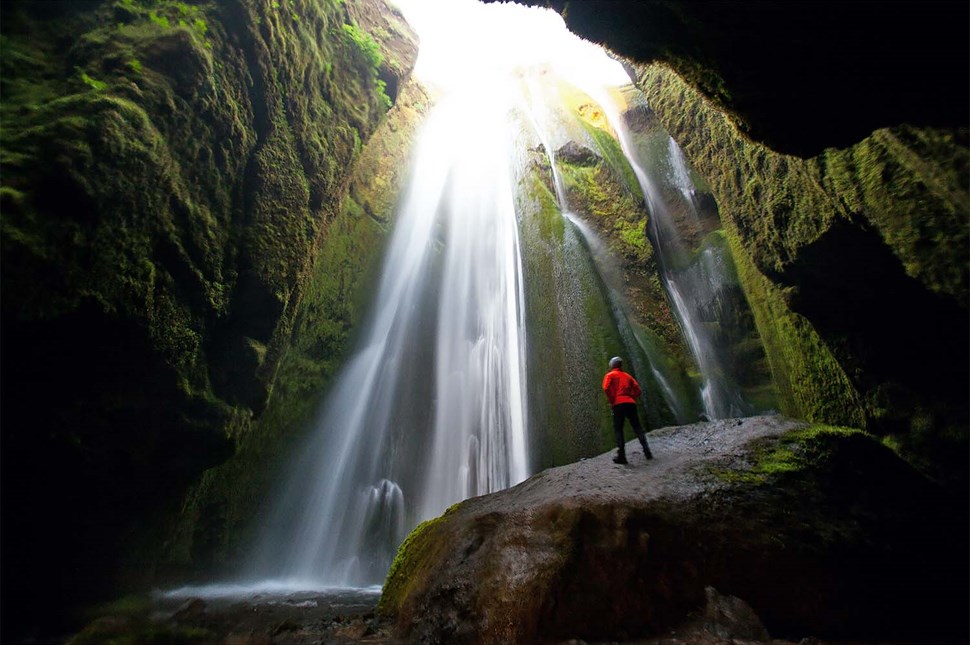
Gljúfrabúi Waterfall
Seljalandsfoss is the superstar of waterfalls. You've probably seen it in countless pictures, especially those taken from behind the waterfall. This majestic beauty plunges 60 m (197 ft) off a high cliff into a small pool below, inviting you to walk around it and bask in its glory. Be careful when the path gets icy, but even in the coldest winter months, Seljalandsfoss always impresses. As you drive along the south coast, it's practically waving at you, impossible to miss on road no. 1.
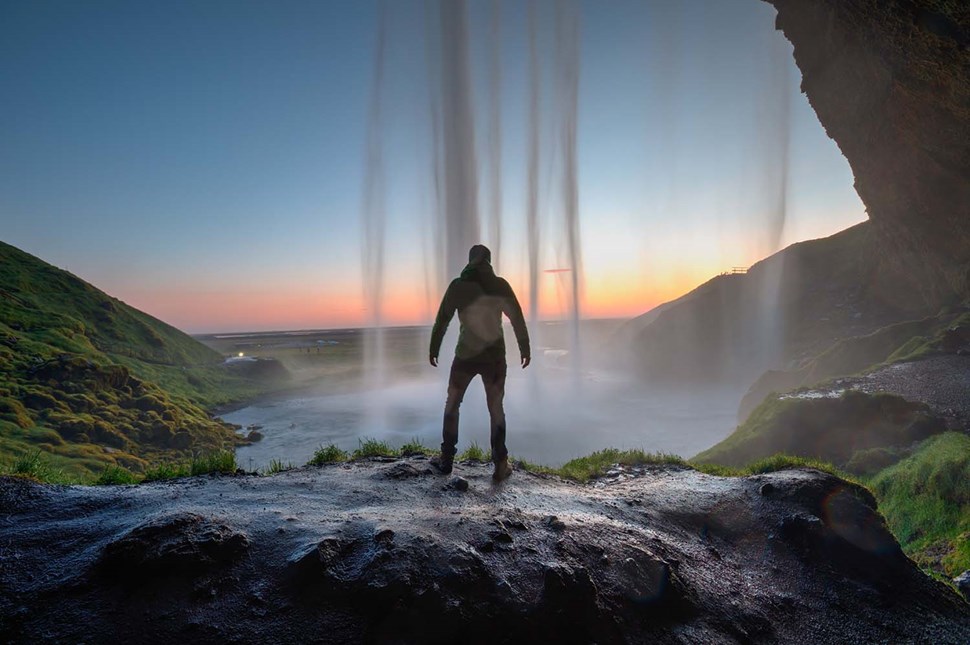
A guy standing in the Beach
Did you know that Seljalandsfoss has a unique claim to fame? It's one of the few waterfalls where you can walk behind the gracefully falling cascade. Talk about a breathtaking experience!
Brúarfoss, also known as the "Bridge Fall," is a hidden gem in Iceland that compensates for its lack of size with its sheer prettiness and uniqueness. Legend has it that a stone bridge once spanned the narrow gorge formed by the waterfall, giving it its name. The water flowing through the valley is so intensely blue that it could give the Blue Lagoon a run for its money!
This little-known waterfall unexpectedly became an overnight social media sensation, drawing hordes of visitors. But let's be honest when a waterfall goes viral, it can create environmental challenges. So here's a gentle reminder to tread lightly upon the earth! It only takes a few misplaced footsteps to cause erosion and damage. Let's be considerate and ensure that these natural beauties continue to enchant us. After all, we want them to remain intact for our planet's well-being. So, let's preserve the magic while we capture it!
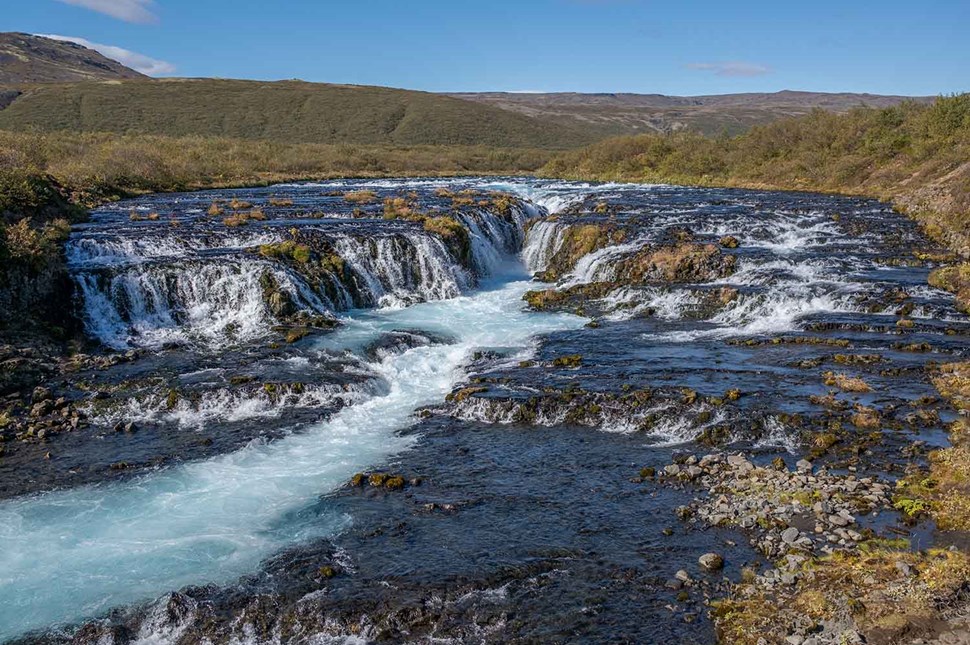
Brúarfoss Waterfall
Located in the northern region of Iceland, Goðafoss, also known as the "Waterfall of the Gods," is a true spectacle, and many call put is as number one of the best waterfalls in Iceland. Legend has it that in the year 1000, a local chieftain threw statues of the Norse gods into the waterfall, symbolizing the country's conversion to Christianity. The waterfall cascades down in a horseshoe shape, approximately 30 meters wide. During winter, the surrounding landscape is often covered in snow, adding a magical touch to the scene.
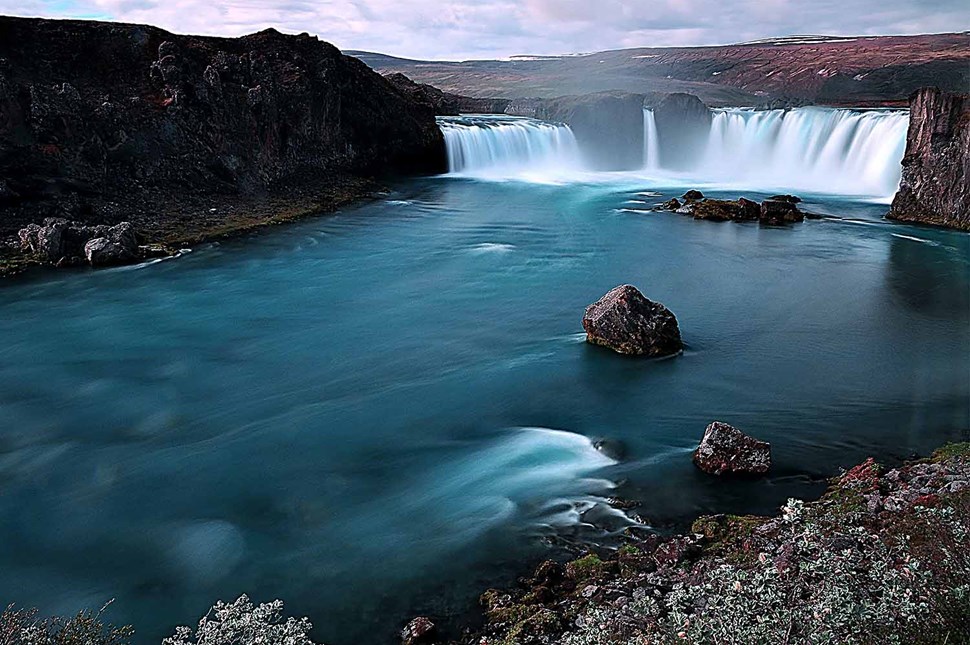
Goðafoss Waterfall
Svartifoss, or the "Black Waterfall," is a captivating natural wonder in Vatnajökull National Park in Iceland. This is one of the best waterfalls in Iceland due to its mesmerizing unique columnar basalt formations surrounding it, resembling a magnificent organ of nature. Legend has it that Svartifoss served as a source of inspiration for the renowned Icelandic architect Guðjón Samúelsson, who incorporated similar basalt columns in his designs, most notably in the iconic Hallgrímskirkja church in Reykjavík. This waterfall's distinct appearance has not only captured the imagination of artists and architects but also enchanted nature enthusiasts and explorers from around the world.
Upon arrival, you'll be greeted by the breathtaking sight of Svartifoss plunging approximately 20 meters into a tranquil pool below. The contrast between the jet-black columns and the frothy white water creates a mesmerizing visual display that seems straight out of a fairytale.
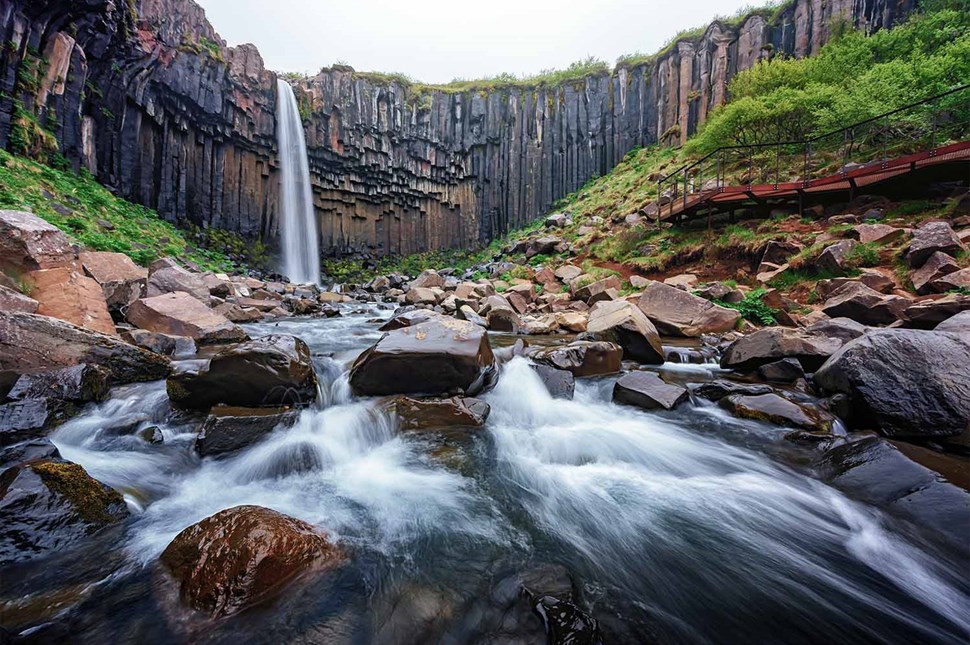
Svartifoss waterfall, a popular attraction in Skaftafell National Park in South Iceland
If a child draws a painting of a waterfall, it will most likely look quite similar to Skógafoss. It’s a perfect rectangle with the river Skógaá falling straight down off the mountain’s edge. If you have a raincoat or don’t mind getting wet, you can follow the river below and get very close to the waterfall. It is also possible to take the stairs next to the waterfall to get a view from above. Those stairs are the start of the Fimmvörðuháls trek to Þórsmörk, and above Skógafoss, there are numerous smaller waterfalls for the next couple of kilometers.
This mighty 25-meter-wide cascade falls 60 meters down, generating clouds of spray and a single or double rainbow on sunny days. That is why many consider Skógafoss one of the best waterfalls in Iceland. There is also a famous legend about the first Viking settler in this area, Þrasis Þórólfsson. He is said to have buried a treasure chest filled with gold behind Skógafoss, which no one has succeeded in recovering so far!
Combine a visit to Skógafoss with a glacier hike at Sólheimajökull, a hunt for the Northern Lights and a variety of other breathtaking experiences on our Sensational Iceland tour.
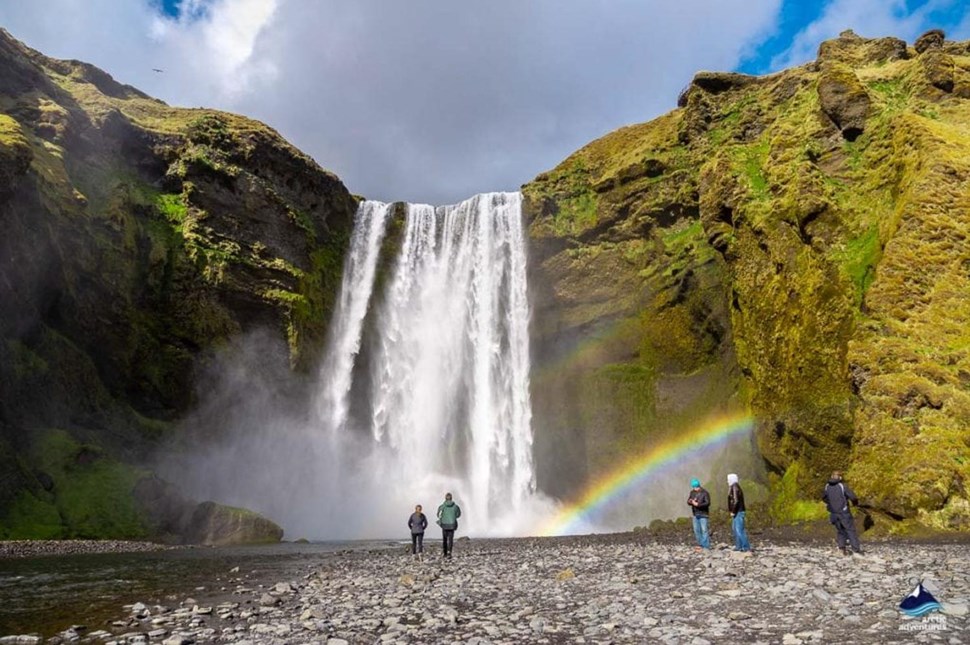
Skógafoss waterfall with a rainbow in South of Iceland
Hengifoss (“Hanging Falls”) is one of the highest waterfalls in Iceland at 128 meters. The falls are located on the Hengifossá River in Fljótsdalshreppur, East Iceland. The surrounding gorge is magnificent, with a colorful rock face that shows the layers of volcanic eruptions from millions of years ago. It’s about a 40-60 minute walk to Hengifoss waterfall, and along the way, you pass by Litlanesfoss, surrounded by very high basalt columns. It is well worth making the 40 to 60-minute hike from the car park to view Hengifoss.
The beauty of a waterfall goes beyond its strength and height. The surrounding scenery can transport you to a magical place. This narrow waterfall cascades down a multicolored cliff, showcasing unique red patterns from volcanic eruptions during Iceland's formation. It is truly one of the best waterfalls in Iceland!
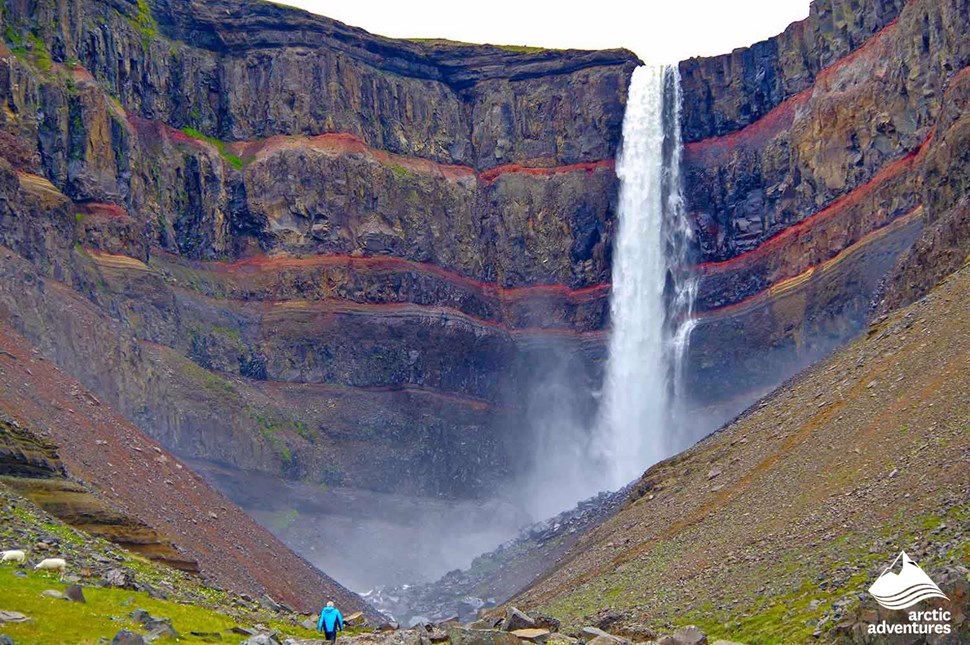
Hengifoss waterfall called "Hanging Falls" in East Iceland
No list of waterfalls in Iceland is complete without Gullfoss, the “Golden Waterfall,” one of the three main sights of the Golden Circle. Gullfoss is one of the best waterfalls in Iceland and the most visited one for an excellent reason. It is listed on The World of Waterfalls’ top 10 list! On sunny days a beautiful rainbow is formed in the mist coming from the waterfall. It falls in two steps with a total of 32 meters drop into a narrow gorge. It’s possible to go river rafting in that same glacial river Hvítá, though further downstream.
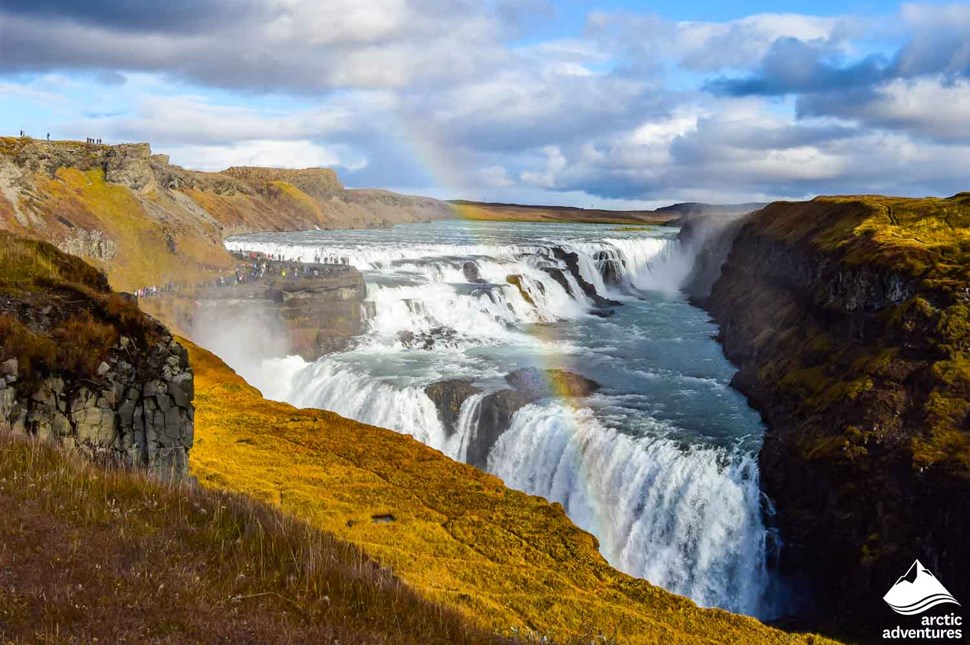
Famous Golden Circle attraction - Gullfoss waterfall during winter
These minor falls are reputed to be amongst the most charming and beautiful waterfalls in Iceland, not undeservedly so!
Situated near the iconic Kirkjufell Mountain on the Snæfellsnes Peninsula, Kirkjufellsfoss (Church Mountain Falls) is a stunning waterfall that complements the majestic peak. This waterfall has gained international fame for its appearance in the popular TV series "Game of Thrones." Its picturesque setting, with the mountain in the background, makes it a favorite spot for photographers and nature enthusiasts.
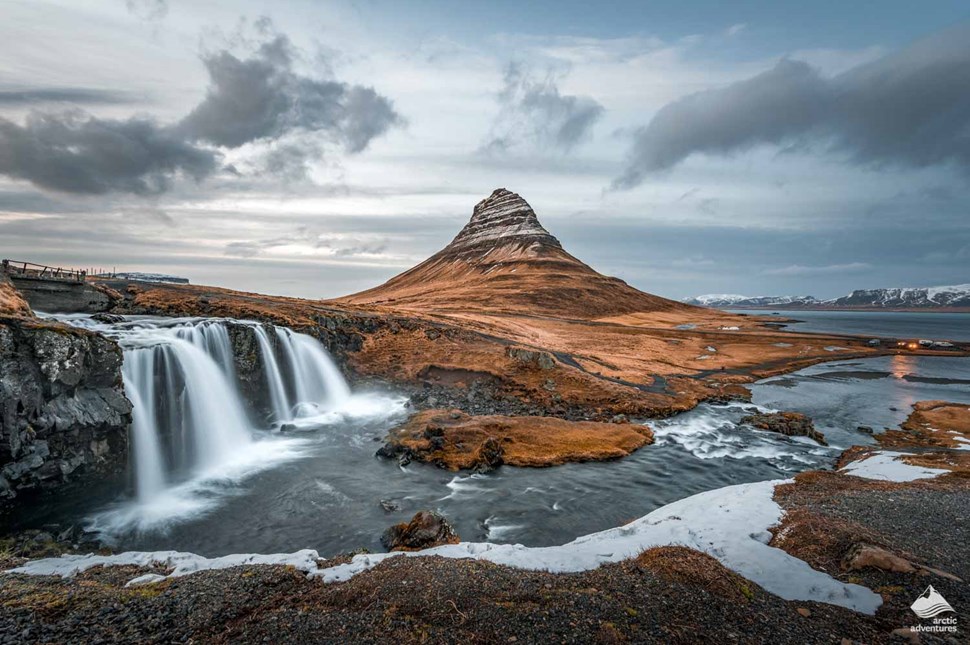
Kirkjufellsfoss waterfall by the Kirkjufellsá river and Kirkjufell mountain in Snæfellsnes, West Iceland
Discover the enchanting Álafoss waterfall on the Varmá river in Mosfellsbær, a charming town near Reykjavík. You can quickly get there by taking the 6 or 15 Strætó bus from the city and enjoying the breathtaking coastal and mountain views. Once you arrive at Háholt, take some time to explore the area. The Álafoss Wool Factory, used to harness the river's power, is now home to the Álafoss Shop, which offers top-quality Icelandic wool, woolen goods, and souvenirs. Don't miss the chance to see these falls, located behind the shop, which are especially enchanting after a snowfall!
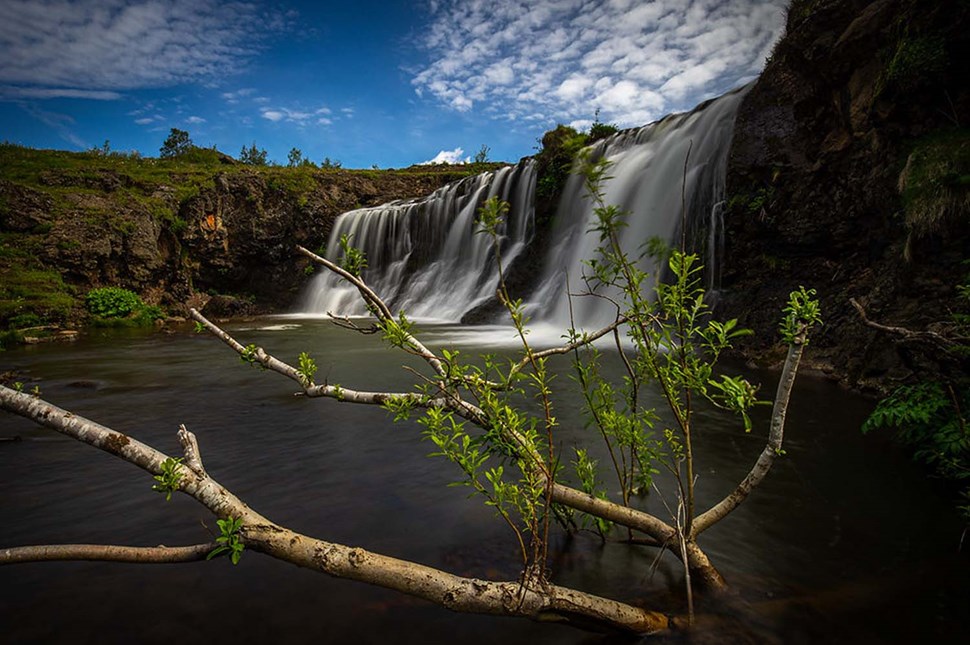
Enchanting Álafoss waterfall
The Aldeyjarfoss waterfall is a stunning sight, nestled within a natural amphitheater of basalt columns in the Suðurárhraun lava field. The Skjáflandarfljót River cascades down from 20 meters, creating a beautiful contrast of white water against the black basalt surroundings. Many consider the Aldeyjarfoss Falls the most impressive waterfall on the Skjáflandarfljót River, making them a worthwhile destination, despite their slightly remote location. You can find them in the Icelandic Highlands, near the northern section of the Sprengisandur mountain road (F 26).
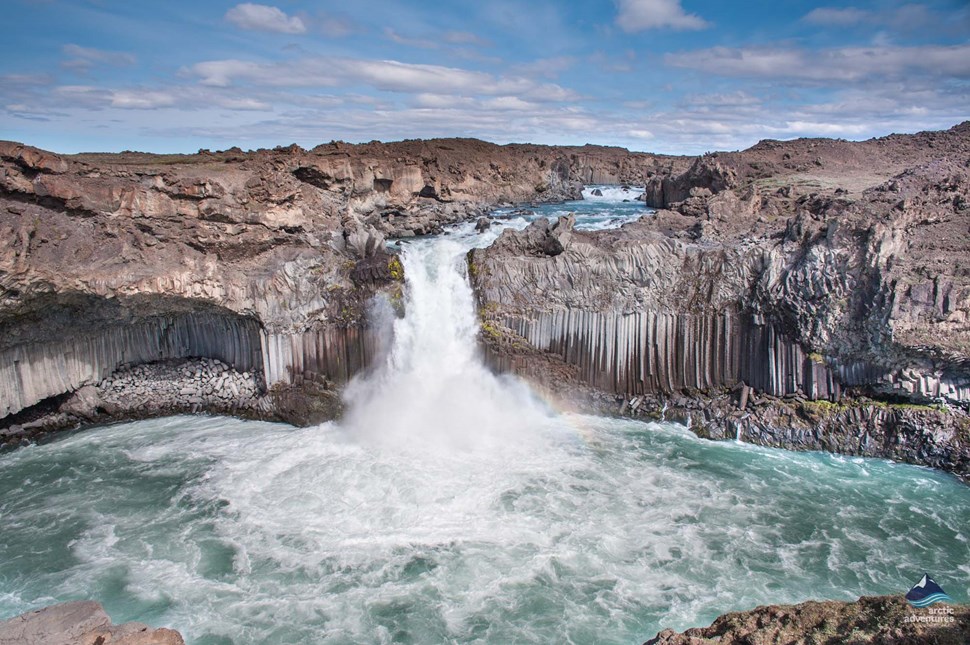
Aldeyjarfoss waterfall surrounded by the basalt columns natural amphitheater
Litlanesfoss waterfall is a stunning narrow towering cascade framed by massive and exceptionally beautiful hexagonal basalt columns. It is situated to the southwest of Egilsstaðir, close to the southern end of Lake Lagarfljót on the Hengifossá River, about 1.5 km from Hengifoss waterfall. The stunning basalt columns surrounding the waterfall, resembling organ pipes, are what sets it apart. These hexagonal columns were formed by volcanic activity millions of years ago, creating a mesmerizing sight as the water flows through them. Visitors can enjoy the scenic hike to reach the waterfall and witness the interplay of water and rock, immersing themselves in the natural beauty of this hidden gem.
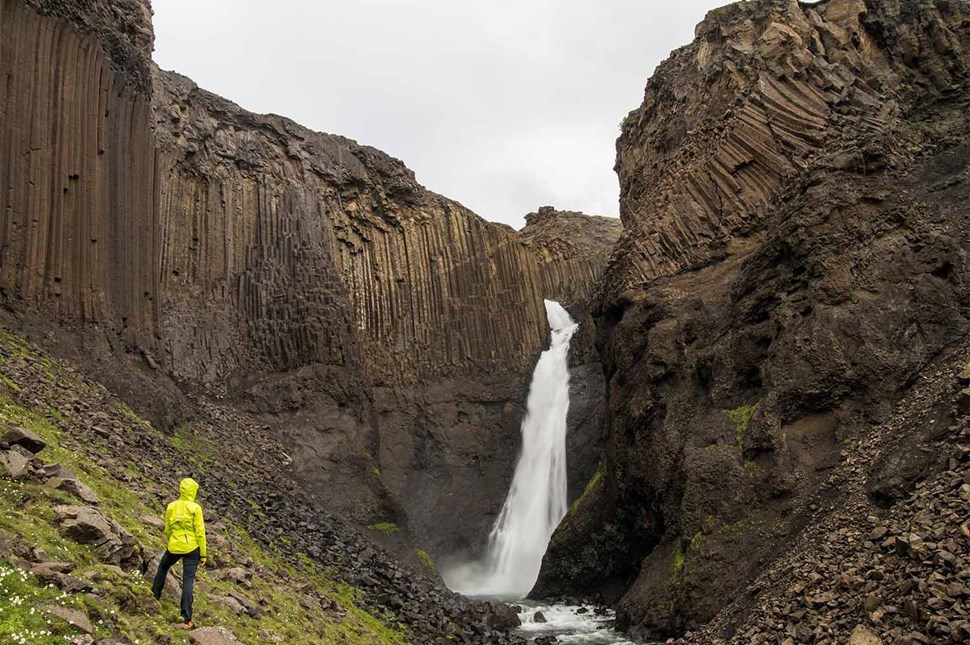
Litlanesfoss waterfall
Barnafoss Waterfall (Children´s Falls) is situated on the Hvítá (White River) in Borgarfjörður, just a short walk away from another waterfall - Hraunfossar (lava falls). These falls are wide and dramatic, as many cascades of tumbling blue water pour over scenic black basalt. There are hiking paths and stunning viewing points.
The falls gained their name from a tragic legend. Two boys drowned after falling from a stone bridge while trying to find their parents. The grieving mother cursed the bridge, causing anyone who crossed it to meet a similar fate. Eventually, an earthquake destroyed the bridge.
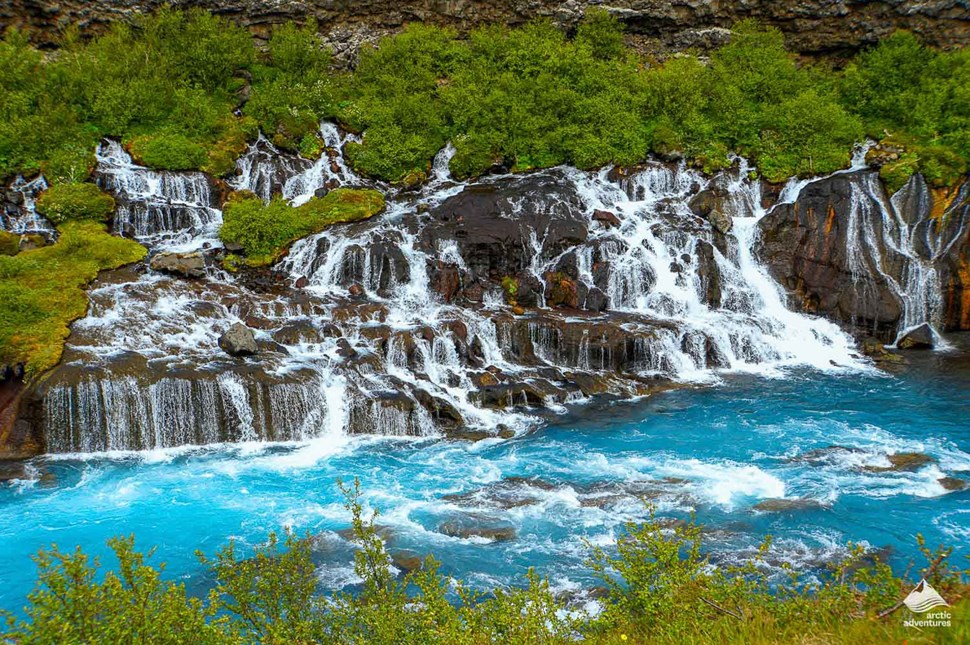
Barnafoss waterfall with beautiful cascades near Hvita river in North Iceland
Hjálparfoss waterfall is a powerful but serene double waterfall situated where the Þjórsá and Fossá rivers meet to the north of the Hekla stratovolcano. Hjálparfoss means “Helping Falls,” which, in the circumstances, is a highly applicable name. Since settlement, people have traversed the ancient Sprengisandur road through the barren highlands. These historic travelers would always be greatly relieved to arrive at the lush highland oasis at Hjálparfoss in Þjórsárdalur. Their horses could rest, graze on fresh grass and recover their strength for the next leg of the journey.
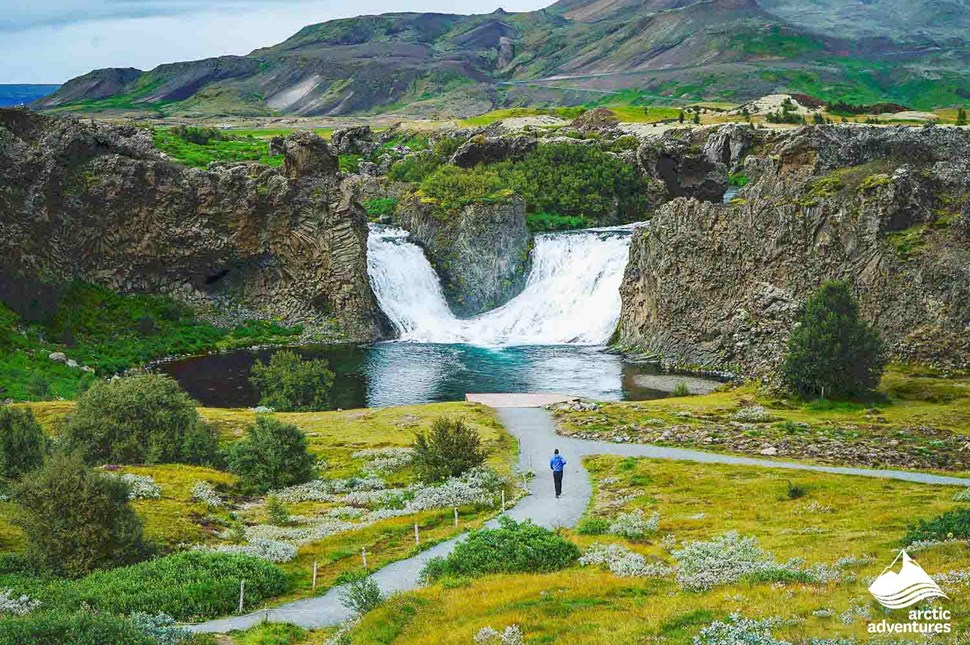
Hjálparfoss - double waterfall in Iceland
The Glymur Waterfall, also known as Glymur Fossinn, is located on the Botnsá River in Botnsdalur on Hvalfjörður. With a 198-meter drop, it is the second-tallest waterfall in the area. It is one of the top waterfalls in Iceland, as the surrounding environment is filled with lush forests and towering mountains, creating a peaceful atmosphere. The area is abundant in summer and early autumn with berry plants. Glymur Waterfall is conveniently located within a 30-minute drive from Reykjavik, and you will find the starting point of the hike that takes you up to the cascade.
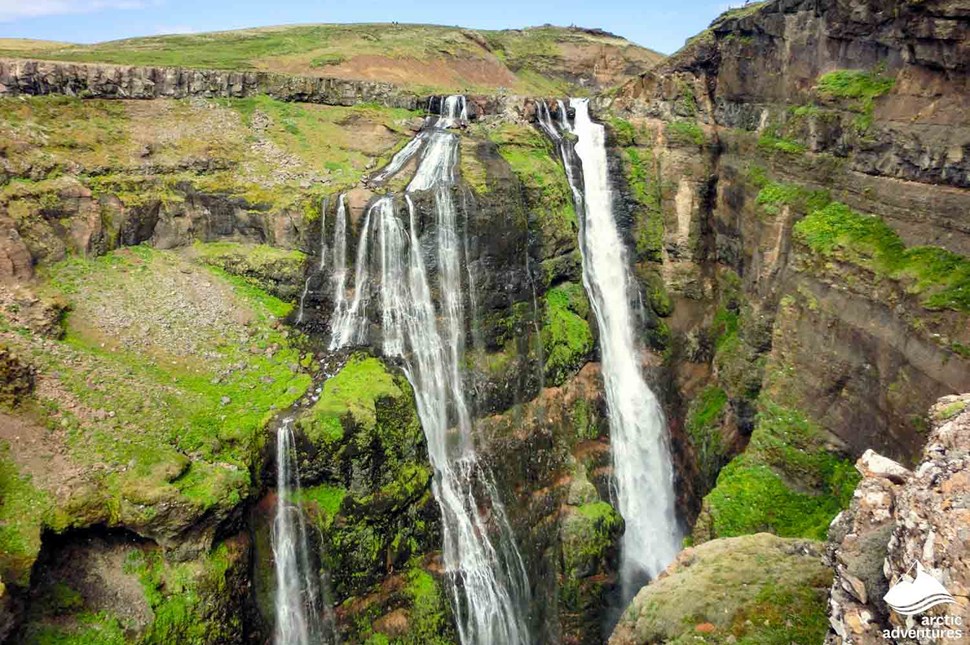
Glymur waterfall - second highest waterfall in Iceland with 198m drop
Háifoss waterfall (“High Falls”) on the Fossá River, a tributary of the Þjorsá River, drops from a height of 122 meters. There are hiking paths that lead to these falls from both directions, one of which begins at Þjóðveldisbærinn Stöng, the Viking Age farm which was destroyed by the 1104 eruption of the nearby Hekla Volcano.
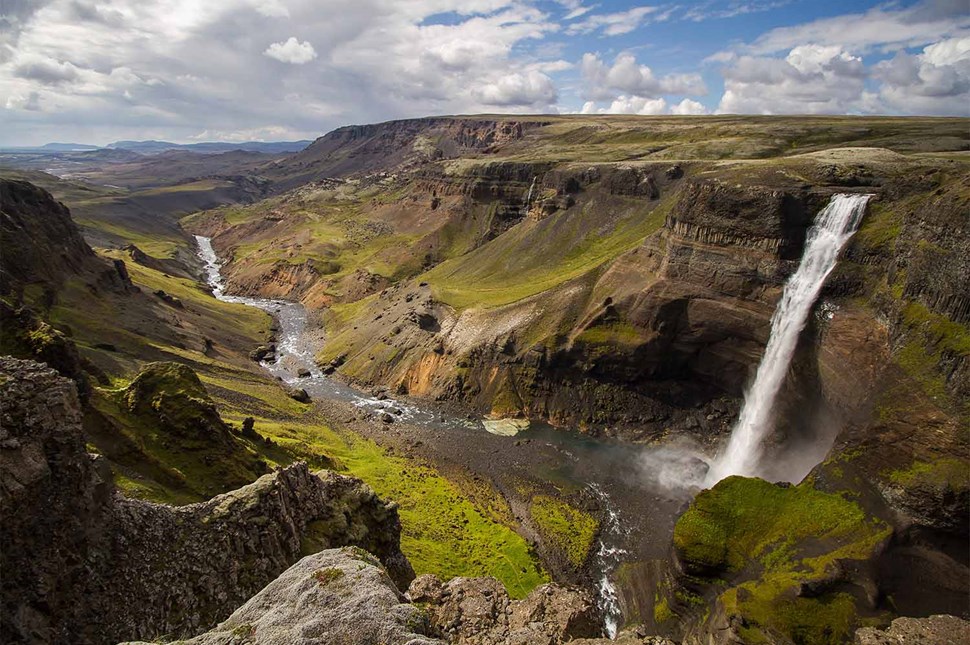
Háifoss waterfall
The farm has been excavated and reconstructed, giving, more than 900 years later, a fascinating insight into life during this period. The name, Háifoss often leads people to conclude that this must be the highest waterfall in Iceland. It is actually in 5th place, but it is no less beautiful, for that matter!
Hrafnabjargafoss is situated on the Skjálfandafljót River, not very far south of Goðafoss. This is sometimes described as a hidden jewel of a waterfall because it receives less attention than other better-known waterfalls in Iceland. If you prefer to appreciate a waterfall in solitude away from crowds, take the mountain road (F 26) to Hrafnabjargafoss! You will be rewarded with spectacular white-water torrents rushing powerfully over black vertical and bent basalt columnar formations. This is an extraordinary sight in the sunshine or beneath a gray sky.
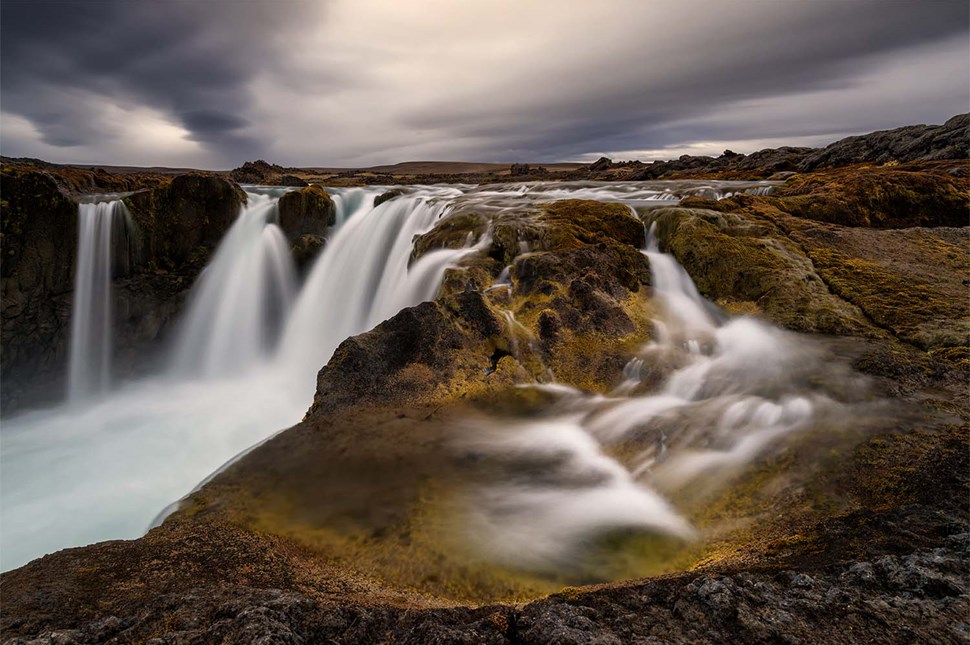
Hrafnabjargafoss on the Skjálfandafljót River
Hraunfossar waterfalls (“Lava Falls”) in Borgarfjörður are a stunning collection of hundreds of cascades. The cascades gush, babble, and tumble over the dramatic black and sometimes green moss-cloaked lava from which they emerge.
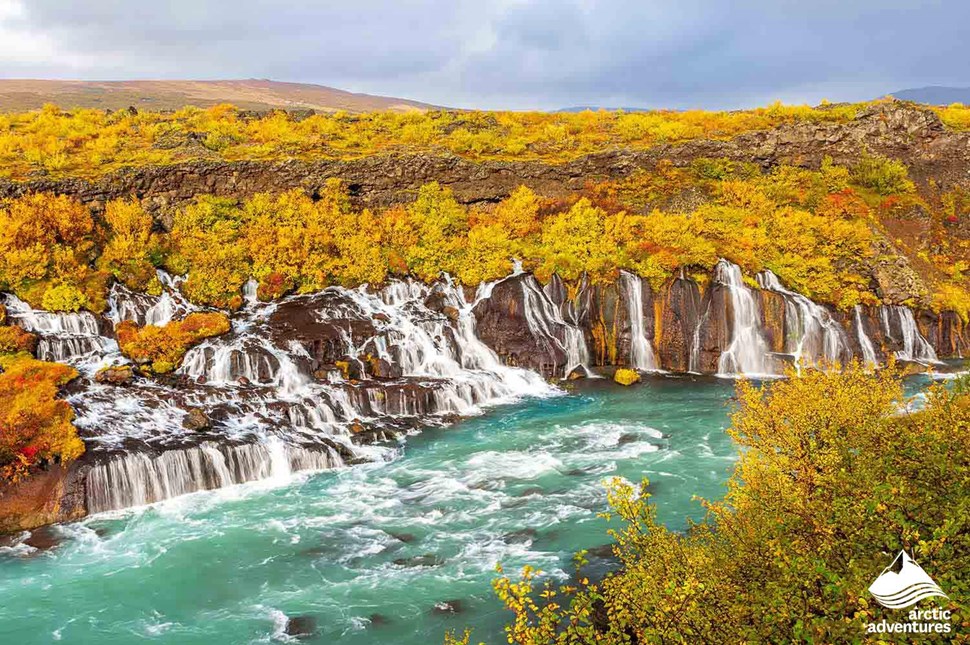
Hundreds cascades of Hraunfossar waterfall in Iceland
These falls are not high, but they extend over a wide area, while the nearby pathways offer excellent viewing and photo opportunities. The falls result from very unusual and beautiful natural phenomena. Rivulets of water have streamed through porous lava from the Hallmundarhraun lava field beneath Langjökull. These ‘hidden’ torrents emerge from the less porous lava in hundreds of little streams, merging into the falls at Hraunfossar before draining into the Hvítá River.
Iceland's mighty rivers have great potential to generate electricity, but harnessing this energy comes at a price. The development of hydroelectricity requires significant construction, including dams and reservoirs, which can drastically change the landscape and river flow, potentially harming or destroying waterfalls. The Kárahnjúkavirkjun power plant is a controversial example of the struggle between economic development and preserving Iceland's natural beauty. The plant was built to fuel an aluminum smelter but required altering river courses and submerging natural features. This has led to a heated debate locally and globally about the value of conservation. Learn more about hydroelectric power in Iceland.
Some of the most famous waterfalls in Iceland include Gullfoss (Golden Waterfall), Seljalandsfoss, Skógafoss, Goðafoss (Waterfall of the Gods), and Dettifoss.
It is estimated that there are over 10,000 waterfalls in Iceland, ranging from small cascades to large, powerful falls.
Morsárfoss is currently considered the tallest waterfall in Iceland, with an approximate height of 240 meters (787 feet). It is located in the Morsárdalur Valley in the southern part of the country, near the Vatnajökull glacier. Hiking near the waterfall requires crossing a moving glacier. It should only be done with the assistance of a local guide familiar with the area and equipped with crampons, ice axes, and safety harnesses.
Glymur, on the other hand, is the second-highest, even though it was previously considered the tallest waterfall in Iceland, with a height of approximately 198 meters (650 feet). More recent measurements have identified Morsárfoss as a taller one.
Swimming in waterfalls in Iceland is generally not recommended due to safety concerns. The water can be extremely cold, and the strong currents and unpredictable conditions pose risks. It is essential to prioritize personal safety and follow any signage or guidelines at each waterfall.
Potentially, yes! When heavy rainfall or melting snow occurs in Iceland, some waterfalls can become hazardous due to rising water levels and currents. To ensure safety, visitors should stick to designated paths, heed all safety warnings, and show respect towards any barriers in place.
Waterfalls in Iceland are primarily formed by glacial and volcanic activity. Glaciers sculpted the landscapes, leaving deep valleys and steep cliffs, while volcanic eruptions created basalt formations and unique geological features that contributed to the formation of waterfalls.
During winter, many waterfalls in Iceland can still be visited, but it's essential to be mindful of weather conditions and road closures that may affect accessibility. Additionally, visitors should exercise caution and wear appropriate footwear due to potentially icy paths at some waterfalls.
Iceland has many beautiful waterfalls that are not well-known and offer unique experiences. Some examples are Hjálparfoss, Haifoss, Rauðfeldsgjá, and Glymur. Visiting these hidden gems can give you a more intimate and personal look at Iceland's natural beauty.
For safety reasons, you should only hike to the tops of Icelandic waterfalls if there are designated hiking paths. To ensure the safety of visitors and the preservation of the surrounding environment, it is crucial to follow any guidelines, barriers, or designated routes provided at each waterfall.
Yes, waterfalls in Iceland usually have names that hold specific meanings. These names are often based on Icelandic words that describe the waterfall's characteristics, mythology, or history. For instance, "Gullfoss" means "Golden Waterfall," while "Skógafoss" translates to "Forest Waterfall."
Yes, glaciers can retreat or melt to uncover new waterfalls. Due to global warming causing glacial melt, we may see more of this phenomenon in the future. For instance, in 2007, the retreat of Morsárjökull, an outlet glacier of Vatnajökull, revealed Morsárfoss waterfall near Kristínatindar in Southeast Iceland. In 2011, one of its cascades was measured at 240 meters high, making it Iceland's tallest waterfall.
Best Sellers